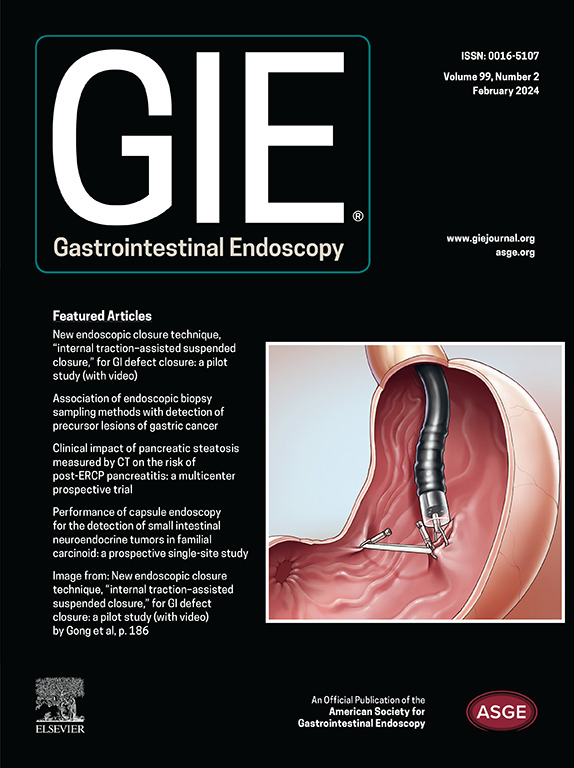隧道或胃袋创建法与传统内镜黏膜下剥离术治疗胃部病变--系统回顾与 Meta 分析。
IF 6.7
1区 医学
Q1 GASTROENTEROLOGY & HEPATOLOGY
引用次数: 0
摘要
背景和目的:隧道内镜黏膜下剥离术(T-ESD)和胃袋创建法ESD(PCM-ESD)被认为比传统ESD(C-ESD)更具技术优势。然而,比较这些技术对胃部病变进行ESD治疗的数据非常有限:方法:查阅了 PubMed 和 Cochrane 数据库中从开始到 2023 年 10 月 31 日的相关研究。纳入的研究比较了 T-ESD 或 PCM-ESD(T/PCM-ESD)与 C-ESD 治疗胃部病变的效果。主要结果是解剖速度和全切。次要结果为R0切除、复发、穿孔和ESD后出血。进行了随机效应荟萃分析:结果:共纳入八项观察性研究(359 名患者--T/PCM-ESD,670 名患者--C-ESD)。T/PCM-ESD与明显更快的剥离速度相关(平均差异:4.42 mm2/min,95% CI:2.05,6.79,I2 = 79%)。在全块切除方面,两组之间没有明显差异(风险比 (RR):1.01,95% 置信区间:2.05,6.79,I2 = 79%):1.01,95% 置信区间(CI):1.00-1.03,I2 = 0%)、R0 切除(RR:1.03,95% CI:0.99-1.07,I2 = 0%)和复发(RR:0.73,95% CI:0.14-3.84,I2 = 0%)方面无明显差异。T/PCM-ESD与穿孔风险显著降低相关(RR:0.21,95% CI:0.06-0.80,I2 = 0%),但ESD后出血率没有显著差异:结论:与传统 ESD 相比,T/PCM-ESD 可以更快、更安全地进行胃 ESD,其全切率、R0 切除率和复发率相当。未来需要进行随机对照试验。本文章由计算机程序翻译,如有差异,请以英文原文为准。
Tunneled or pocket creation method versus conventional endoscopic submucosal dissection for gastric lesions: a systematic review and meta-analysis
Background and Aims
Tunneled endoscopic submucosal dissection (T-ESD) and pocket creation–method ESD (PCM-ESD) are considered to have technical advantages over conventional ESD (C-ESD). However, data comparing these techniques for ESD of gastric lesions are limited.
Methods
PubMed and Cochrane databases were reviewed for relevant studies from their inceptions to October 31, 2023. Studies comparing T-ESD or PCM-ESD (T/PCM-ESD) with C-ESD for gastric lesions were included. The primary outcomes were dissection speed and en-bloc resection. Secondary outcomes were R0 resection, recurrence, perforation, and post-ESD bleeding. A random effects meta-analysis was conducted.
Results
Eight observational studies (359 patients with T/PCM-ESD, 670 patients with C-ESD) were included. T/PCM-ESD was associated with a significantly faster dissection speed (mean difference, 4.42 mm2/min; 95% confidence interval [CI], 2.05-6.79; I2 = 79%). There were no significant differences between the groups in terms of en-bloc resection (risk ratio [RR], 1.01; 95% CI, 1.00-1.03; I2 = 0%), R0 resection (RR, 1.03; 95% CI, 0.99-1.07; I2 = 0%), and recurrence (RR, 0.73; 95% CI, 0.14-3.84; I2 = 0%). Although T/PCM-ESD was associated with a significantly lower risk of perforation (RR, 0.21; 95% CI, 0.06-0.80; I2 = 0%), post-ESD bleeding rates were not significantly different.
Conclusions
T/PCM-ESD facilitates faster and safer gastric ESD than C-ESD, with similar en-bloc resection, R0 resection, and recurrence rates. A future randomized controlled control trial is required.
求助全文
通过发布文献求助,成功后即可免费获取论文全文。
去求助
来源期刊

Gastrointestinal endoscopy
医学-胃肠肝病学
CiteScore
10.30
自引率
7.80%
发文量
1441
审稿时长
38 days
期刊介绍:
Gastrointestinal Endoscopy is a journal publishing original, peer-reviewed articles on endoscopic procedures for studying, diagnosing, and treating digestive diseases. It covers outcomes research, prospective studies, and controlled trials of new endoscopic instruments and treatment methods. The online features include full-text articles, video and audio clips, and MEDLINE links. The journal serves as an international forum for the latest developments in the specialty, offering challenging reports from authorities worldwide. It also publishes abstracts of significant articles from other clinical publications, accompanied by expert commentaries.
 求助内容:
求助内容: 应助结果提醒方式:
应助结果提醒方式:


